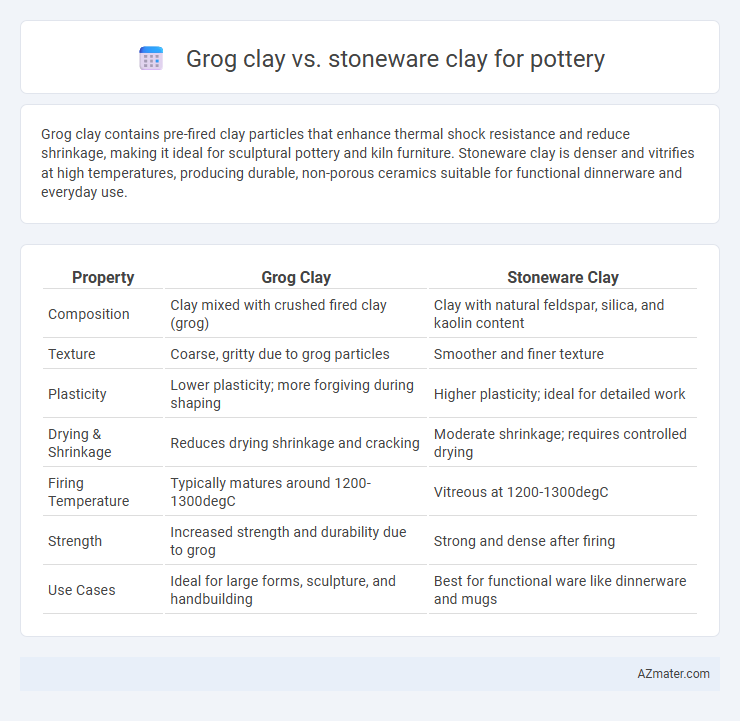Grog clay contains pre-fired clay particles that enhance thermal shock resistance and reduce shrinkage, making it ideal for sculptural pottery and kiln furniture. Stoneware clay is denser and vitrifies at high temperatures, producing durable, non-porous ceramics suitable for functional dinnerware and everyday use.
Table of Comparison
| Property | Grog Clay | Stoneware Clay |
|---|---|---|
| Composition | Clay mixed with crushed fired clay (grog) | Clay with natural feldspar, silica, and kaolin content |
| Texture | Coarse, gritty due to grog particles | Smoother and finer texture |
| Plasticity | Lower plasticity; more forgiving during shaping | Higher plasticity; ideal for detailed work |
| Drying & Shrinkage | Reduces drying shrinkage and cracking | Moderate shrinkage; requires controlled drying |
| Firing Temperature | Typically matures around 1200-1300degC | Vitreous at 1200-1300degC |
| Strength | Increased strength and durability due to grog | Strong and dense after firing |
| Use Cases | Ideal for large forms, sculpture, and handbuilding | Best for functional ware like dinnerware and mugs |
Introduction to Grog Clay and Stoneware Clay
Grog clay contains pre-fired clay particles that enhance its texture, reducing shrinkage and improving resistance to thermal shock, making it ideal for sculptural and functional pottery. Stoneware clay is a dense, non-porous material fired at high temperatures, valued for its durability and ability to vitrify into a glass-like finish suitable for functional wares like dinnerware. Both types offer distinct advantages depending on the desired pottery characteristics, with grog clay providing added strength and stoneware clay ensuring water resistance and toughness.
Composition and Material Differences
Grog clay contains pre-fired clay particles that create a rough texture, enhance thermal shock resistance, and minimize shrinkage during drying and firing, making it ideal for sculptural and functional pottery requiring durability. Stoneware clay is composed of natural minerals like kaolin, ball clay, and feldspar, providing a dense, vitrified, and non-porous body after firing at high temperatures, which offers strength and water resistance. The primary material difference lies in grog's added fired clay granules versus stoneware's unaltered raw clay components, affecting workability and final texture.
Workability and Handling
Grog clay contains pre-fired clay particles that improve workability by reducing shrinkage and cracking during drying and firing, making it ideal for hand-building and sculptural pottery. Stoneware clay, known for its smooth texture and plasticity, offers excellent handling but can be prone to warping if not managed carefully. Potters seeking durability and ease of shaping often prefer grog clay, while stoneware clay suits those prioritizing finer detail and a refined surface finish.
Firing Temperature and Durability
Grog clay contains pre-fired clay particles that enhance thermal shock resistance and reduce shrinkage, firing typically between 1200degC to 1300degC, making it ideal for high-temperature stoneware pots. Stoneware clay fires at a similar or slightly higher range, around 1200degC to 1350degC, producing dense, durable ceramics with excellent water resistance. The inclusion of grog results in a more durable, less crack-prone final piece, while pure stoneware clay offers a smoother texture but may be more susceptible to thermal stress.
Surface Texture and Finish
Grog clay contains pre-fired clay particles that provide a coarse, gritty surface texture ideal for rustic, tactile pottery finishes. Stoneware clay is finer and smoother, allowing for sleek, polished surfaces with more refined glazing results. The gritty inclusions in grog clay reduce shrinkage and add strength, while stoneware's dense composition supports high-fired, vitrified finishes with enhanced durability.
Strength and Structural Integrity
Grog clay contains pre-fired clay particles that enhance the strength and structural integrity of pottery by reducing shrinkage and increasing resistance to thermal shock. Stoneware clay is naturally dense and durable, offering high mechanical strength and low porosity, making it ideal for functional pottery that needs to withstand daily use. Grog additives improve the workability and fracture resistance of stoneware clay, combining toughness with durability for robust ceramic pieces.
Suitability for Pottery Techniques
Grog clay, enriched with pre-fired clay particles, enhances structural strength and reduces shrinkage, making it ideal for hand-building techniques such as coil and slab construction. Stoneware clay, known for its durability and vitreous properties after firing, suits wheel-throwing and high-fire applications, providing a balance of plasticity and resilience. Both clays accommodate various glazing options but differ in texture and firing temperature, influencing the choice based on the pottery technique employed.
Cost and Availability Comparison
Grog clay generally costs more than stoneware clay due to the added processing of grog particles, which enhances texture and reduces shrinkage during firing. Availability of grog clay can be limited in some regions because it requires specialized manufacturing, whereas stoneware clay is widely accessible and commonly stocked by ceramic suppliers worldwide. For potters on a budget or needing consistent supply, stoneware clay offers a more cost-effective and readily available option compared to grog clay.
Pros and Cons of Grog Clay
Grog clay contains pre-fired clay particles that improve structural strength and reduce shrinkage, making it ideal for large, heavy pottery and sculptural work where durability is essential. The added grog enhances texture and porosity, allowing better airflow during firing, but it can result in a rougher surface that may require additional smoothing if a fine finish is desired. However, grog clay is less plastic and harder to shape than stoneware clay, which could challenge beginners or those wanting delicate, intricate forms.
Pros and Cons of Stoneware Clay
Stoneware clay offers durability and versatility, firing at high temperatures between 1,200degC and 1,300degC, which results in a dense, non-porous ceramic ideal for functional pottery such as dinnerware and cookware. Its plasticity makes it relatively easy to shape, but it can be heavier and less porous compared to grog clay, which contains pre-fired particles that improve drying and reduce shrinkage. Stoneware clay's main drawbacks include potential warping during firing and a tendency to crack if not properly managed, requiring skilled handling and controlled kiln environments.

Infographic: Grog clay vs Stoneware clay for Pottery
 azmater.com
azmater.com